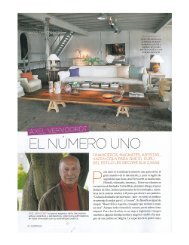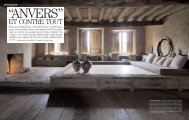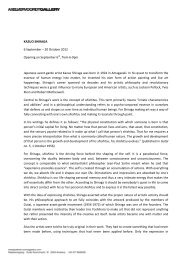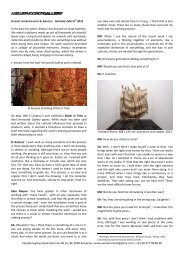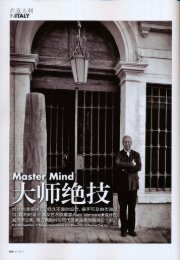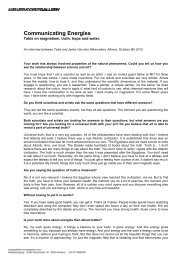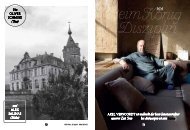Interview with Otto Boll - Axel Vervoordt
Interview with Otto Boll - Axel Vervoordt
Interview with Otto Boll - Axel Vervoordt
You also want an ePaper? Increase the reach of your titles
YUMPU automatically turns print PDFs into web optimized ePapers that Google loves.
<strong>Interview</strong> <strong>with</strong> <strong>Otto</strong> <strong>Boll</strong><br />
by Jenke Van den Akkerveken<br />
Antwerp, 11.12.2012<br />
<strong>Otto</strong> <strong>Boll</strong>’s installations cut through emptiness. His fine, steal sculptures are like immaterial lines drawn in<br />
space. They balance on the thin line between the visible and what cannot be seen. <strong>Boll</strong> creates sculptural<br />
experiences that destabilize the spectators’ position and challenge them to experience their surroundings<br />
in a totally new way.<br />
On the occasion of <strong>Otto</strong> <strong>Boll</strong>’s exhibition at <strong>Axel</strong> <strong>Vervoordt</strong> Gallery (6 December 2012 – 26 January<br />
2013), Jenke Van den Akkerveken interviewed the artist, confronting him <strong>with</strong> the way the sculptures he<br />
installed at the gallery can influence the viewer's experience of space.<br />
JVA: The questions I am going to ask you are experiential. They come from a personal experience of<br />
your work. To me your floating sculptures are like lines, immaterial lines, that are drawn into space. It<br />
seems like they are cutting through emptiness. Like they are holes in space. What does the concept of<br />
the void mean to you and how do your sculptures relate to it?<br />
OB: A void for me is a beginning. There is nothing and from this point you have to start anew. And to<br />
have the feeling of the void in the back of your mind, it’s just like looking for another country. It has<br />
something to do <strong>with</strong> possibility. A sense of the known possibility is necessary in combination <strong>with</strong> the<br />
void. On the one hand there is nothing, but from this point onwards I start to build something, and it has to<br />
fill the nothing <strong>with</strong> something I do by myself.
JVA: So in a way the void is a fullness as well: a plenitude of possibilities.<br />
OB: Yes. It sounds paradoxical but it is the same. Fullness and nothingness come together.<br />
JVA: And how do your sculptures relate to this? Can we see them as possibilities in this void, are they<br />
revealing a part of the void? How would you see this?<br />
OB: I like to see my sculptures – especially the suspended ones, but also the other ones – as tools, as<br />
tools for looking. They are a kind of… they help me to open my eyes. So to live <strong>with</strong> these sculptures can<br />
lead to an opening of the eyes, to an opening of the view you have on your surroundings, on your own<br />
life, and they bring you in the “possibility”, into the tension to see things which you possibly could not have<br />
seen <strong>with</strong>out these sculptures. It makes you… aware. A great deal of awareness is involved in my<br />
sculptures.<br />
JVA: This perfectly brings me to my next question, because when I look at your work, be it the floating<br />
sculptures, or the steles, I feel that my gaze is slowed down. You have to look closer in order to see the<br />
sculptures, only to find that your eye can never fix them. Would you say that your work focuses on a<br />
visual experience?<br />
OB: Yes, I think the visual experience is necessary, for me it is necessary as a way of thinking, already. I<br />
cannot really describe how it happened <strong>with</strong> the first suspended sculptures, but I believe that it had<br />
nothing to do <strong>with</strong> just rational thought at all. Suddenly this form of sculpture was there and I think it had<br />
something to do <strong>with</strong> what I was thinking of visually when it happened.<br />
Sometimes you find yourself in a ordinary situation, for example, you are reading a book, you are<br />
concentrated and then suddenly you think you have got it. You have found the right solution for<br />
something, or you have understood something. This was the situation <strong>with</strong> the beginning of these<br />
sculptures, but I think they were already prepared for by other things I had done before. In my workshop I<br />
was constructing a piece which had to hang on the wall. The construction of this piece was interesting for<br />
me. I looked at it as I was constructing it, piece by piece. I had a view on it on a daily basis and so this<br />
picture I got from the construction of this thing was in my mind. It was one piece of the visual<br />
development of these suspended sculptures.<br />
So often I say it is necessary for me to be by myself in a workshop, to do a lot of things by myself<br />
because you have a lot of these pictures in your mind when you are working <strong>with</strong> different materials and<br />
so on. These pictures you have in your mind are combined <strong>with</strong> thinking, for me. So I’m working <strong>with</strong> my<br />
hands and the pictures in my head. Hands and head belong together.<br />
JVA: So the process of making a work is important for you?<br />
OB: Yes, it is very important.
JVA: And what about the visual experience of the viewer? Because now you have talked about the<br />
beginning, how your works are created, and about the importance of the visual experience for you, as an<br />
artist; but is it important for the viewer as well?<br />
OB: Yes, I think if a spectator is interested in looking at the work and takes his time to look at it, I say he<br />
should also come into contact <strong>with</strong> my idea about looking.<br />
My idea of when a sculpture or an art work is really perfect for me, is when I feel that what is outside fits<br />
<strong>with</strong> what is inside…<br />
JVA: Is this inside the visual image you were talking about?<br />
OB: Yes. Outside – inside. When this happens to me, then I think I’m also a little bit critical <strong>with</strong> my view<br />
on the things I do. If it is this way for me, it can also be so for another person. That is my point of view.<br />
What I often like to say is that you have the imagination of the thing and you know and feel how it has to<br />
be – this is one point, but you have to do it, you have to make it.<br />
JVA: It has to converge, to come together…<br />
OB: Indeed, and when it happens, it is real. First it is in your mind and then you can see it. Then there is<br />
another feeling in your breathing and your heart … and you see…<br />
JVA: Your body feels it is right.<br />
OB: Yes, that’s the best situation. It does not happen very often.<br />
JVA: Is that why you like to be in control as well, of the hanging, and everything? To make it fit?<br />
OB: Yes.<br />
JVA: I am fascinated by the fine endings of your floating sculptures, especially by the point where they<br />
almost seem to dissolve into nothingness. To me those points are like thresholds, they are like inbetweens.<br />
How do you feel about this idea, could you elaborate on that?<br />
OB: If you try to imagine that this is just a round stick <strong>with</strong>out fine endings, it is just a flying stick in the air.<br />
This Auflösung, this dissolution, is necessary, it’s just a moment from no-thing to thing. The sculpture<br />
becomes a strange, uncanny object. This is not a thing hung from the ceiling. It is weightless, so if you<br />
see the black small peak against a white wall, the white is ‘overblending’, it folds over, and so you get the<br />
impression that you do not know where the end is.<br />
JVA: And you don’t have the depth.
OB: You cannot do the same <strong>with</strong> a white line in front of black. It’s not possible. And that is why the<br />
sculptures are mostly black in front of a white wall.<br />
JVA: <strong>Otto</strong>, one last question, following on from our discussion about the experiential nature of your work.<br />
How does your work relate to time?<br />
OB: Well, I would like to say my work is timeless. Less time. As it is in-between, it is also less time. You<br />
have your own time <strong>with</strong> the sculptures.<br />
JVA: Your own time out of time…<br />
OB: For me especially the sculptures are something you are <strong>with</strong> in a space, which means the sculpture<br />
is just like a person you are <strong>with</strong>…<br />
JVA: A person <strong>with</strong> whom you share the same dimension of time...<br />
OB: Exactly. If a person, who does not know what kind of sculptures I make, would ask me about my<br />
sculptures, I would like to be together <strong>with</strong> this person <strong>with</strong> only my sculptures in a space and I would say<br />
nothing.<br />
One can only experience my work. It is a prime experience, so you cannot imagine what this sculpture is<br />
like when you see a photograph. It has… I don’t know what kind of word I could use, in German it’s<br />
primärer Erfahrungswert.<br />
JVA: You have to experience your work in a certain time and space in order to fully understand it.<br />
OB: Yes, I had the same experience <strong>with</strong> this interview (laughter).



